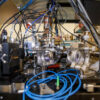Using state-of-the-art magnetic imaging, a Cornell-led collaboration has for the first time characterized a key property of the superconducting state of a class of atomically thin materials that are too difficult to measure due to their minuscule size.
The group’s paper, “Superfluid Response of an Atomically Thin Gate-Tuned van der Waals Superconductor,” published April 12 in Nature Communications. The lead author is doctoral student Alexander Jarjour.
The project was led by Katja Nowack, assistant professor of physics in the College of Arts and Sciences and the paper’s senior author, whose lab investigates emergent phenomena and order in quantum materials via a range of scanning probes. The group’s superconducting quantum interference device, or SQUID, is particularly adept at working at low temperatures and in small magnetic fields.
The researchers applied their SQUID—one of only several in the U.S.—to the inorganic compound molybdenum disulfide, which is known as a van der Waals material. While chemical bonds are generally considered to be the superglue of condensed matter physics, atoms can also be held together by the electric polarization of van der Waals forces, which are comparatively weaker but have their own unique perk. Van der Waals materials, such as graphene, can be exfoliated and their flakes assembled into atomically thin layers.
“The beauty of van der Waals materials is that there’s a huge array of different types of physical systems, like superconductors and topological insulators, you can make in these really thin, micron-scale flakes,” Jarjour said. “The bad part is that people over the last decades have invented analysis tools to try to understand what’s going on inside of bulk materials, meaning big chunks of stuff, and those tools, more or less without exception, don’t work for van der Waals materials because they’re too thin and they’re too small.”
The typical method to probe van der Waals superconductors is through measuring electrical transport, which can show a phase transition to zero resistance has occurred when the critical temperature is reached. But after that, according to Nowack, “essentially, you turn blind,” because the method doesn’t provide any information about how many electrons are participating—and in what way—in the superconducting state.
The team improved upon that approach by spin coating their SQUID with a micron-thick layer of ionic liquid and positioning it as close as possible to the fragile sample without damaging it.
The SQUID revealed the material was expelling the device’s magnetic field.
“Seeing magnetic field expulsion, in combination with very low resistance, is a really clear signature that something is a superconductor,” Jarjour said. “We’ve set a new milestone for someone who finds a new van der Waals superconductor and really wants to prove it’s a superconductor.”
Just as importantly, the expulsion provided new information about the electrical transport in van der Waals materials.
“How well the superconductor expels magnetic field gives us information about how many electrons are participating,” Jarjour said. “We measured that for the first time in an atomically thin van der Waals superconductor, and we found actually there’s a lot of electrons that are not participating in the superconducting state. We believe that we have a reasonable case, based on the data, that is because there’s electronic disorder in these samples.”
The findings also show how 2D superconductors differ from their bulkier 3D relatives. In some devices, the researchers observed signatures of a Berezinskii-Kosterlitz-Thouless phase transition, which is specific to 2D materials, whereas in others they found an expanded superfluid response.
“I’m excited that we can use this tool now and apply it to this large class of really fascinating superconductors, which are a rich playground in condensed matter physics for realizing extraordinary superconducting phenomena,” Nowack said.
Co-authors include doctoral student G. M. Ferguson; Brian Schaefer; former postdoctoral researcher Menyoung Lee; Yen Lee Loh of the University of North Dakota; and Nandini Trivedi of Ohio State University.
More information:
Alexander Jarjour et al, Superfluid response of an atomically thin gate-tuned van der Waals superconductor, Nature Communications (2023). DOI: 10.1038/s41467-023-37210-8
Provided by
Cornell University
Citation:
Magnetic imaging unlocks crucial property of 2D superconductor (2023, May 1)



